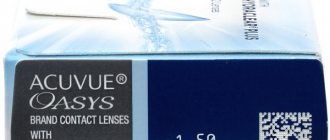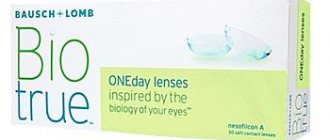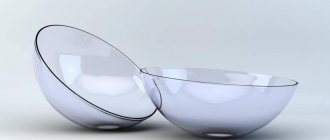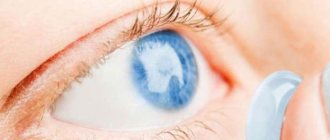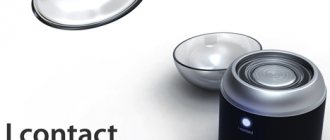What containers should you store lenses in?
The lens storage container consists of two small containers connected to each other.
Important! The device must always be tightly closed and therefore airtight. Therefore, every time you close it, you need to check whether the lid of the container is tightly screwed on. This is especially important in cases where you move it from place to place, for example, when you take it with you on a visit.
This device is equipped with a sealed lid that prevents the solution from evaporating or accidentally pouring out.
To prevent the container from becoming a source of germs and bacteria, it needs to be properly cared for.
How to properly clean the lens container?
Lens users know how important it is to care for them correctly and regularly. Cleansing contact correction products from lipid and protein deposits helps prevent the appearance of harmful microorganisms on their surface that can harm the eyes. But not only the lenses require care, but also the container itself.
Did you know that with the help of a properly carried out cleaning procedure for contact optics, you can get rid of almost 90% of the bacteria that get on it in a day? The same rule applies to the container for ophthalmic products, so it must always be clean. Otherwise, there is a risk of infection in the eyes. You can wash it with the same solution that is used to care for lenses.
Most disinfectants are capable of destroying such dangerous bacteria as Acanthamoeba, but, unfortunately, they do not always act on cysts (the temporary form of existence of microorganisms). The latter, as a rule, get on the lenses from tap water and can also accumulate in the container. That is why it is necessary to periodically replace it with a new one. This needs to be done every month. This precaution will protect the visual organs from the development of infectious diseases. Also, the container should be replaced when purchasing new ophthalmic products. We talked about replacing it, now we just need to figure out the rules of care.
Rules for caring for your contact lens container:
- Please remember not to use tap water to clean optical products or containers. For this purpose, only a special multi-purpose solution is suitable, which must be selected by an ophthalmologist.
- Do not reuse the disinfectant; it must be changed each time you put removed ophthalmic products in it. The fact is that bacteria could remain in it from the previous cleaning procedure, which can be dangerous to the cornea and eyes.
- To properly clean a container, pour out the old solution, add new solution, and rinse. During the procedure, do not forget about hard-to-reach places, as debris and dirt particles often accumulate in them.
- It is also worth additionally inspecting the container using a magnifying glass or magnifying glass. This will make it much easier to determine the degree of contamination.
- For convenience, it is recommended to purchase two or three containers at once. One can be washed and dried, the second can be used, and the third can be taken with you in reserve if necessary.
As you can see, there is nothing complicated in the container care procedure. If you still have any questions, you can always read the instructions for the lens cleaning solution or consult an ophthalmologist for advice.
Lens container
The combination of a properly selected container and solution guarantees reliable protection against harmful microorganisms and prevents the development of keratitis.
According to the form of execution, containers can be horizontal or vertical. Horizontal ones are more common; they have two cells in their design , intended for each product, and are complemented by tweezers and a case.
The design of vertical products often has the possibility of rotating stacking , ensuring ideal cleaning of each product.
Such systems are equipped with special holders for products that are appropriately marked for each solution. After the special system is immersed in a container with a cleaning solution, several intensive rotations of the lid occur.
Attention! Vertical containers with a rotating system require great attention, because as a result of any careless movement the lens can be damaged by the holder.
There are options for containers with additional functions and properties - for example, with an antibacterial coating based on inorganic silver ions, as well as a timer.
Contact lens container: care instructions
Proper care of your lens storage device will help avoid microbial keratitis and other eye diseases, and will also extend the life of this device.
First of all, people are usually interested in the question of how to wash the lens container?
Let's make step-by-step instructions and figure out how to store lenses in a container:
- Each product must be placed in the appropriate cell.
- Immediately after putting it on, you should pour all the liquid out of the container and rinse with a special solution - under no circumstances should you use tap water.
- After cleaning, the container should dry in fresh air.
- Once a week, thermal cleaning is required - for this, the product must be treated with boiling water or hot steam.
- It is recommended to change the product at the same time as purchasing new vision correction products.
Contact lens care products
Why do contact lenses require care?
Soft contact lenses contain a significant amount of water and therefore must be stored in an aqueous saline solution when not in the eye to maintain their performance.
During storage, lenses may become infected with microorganisms that cause various eye diseases. Infection occurs especially intensively in cases where solutions that are not intended for this purpose are used for storage. Contact lenses are susceptible to microorganisms when worn, as the moist, warm environment of the eye is ideal for the growth of bacteria, protozoa and fungi.
When worn, the lens is also exposed to contamination by tear and environmental products.
Consequently, there is a need to use a special contact lens care system that would minimize the negative consequences of wearing lenses.
Modern soft contact lens care systems include the following groups of drugs:
- disinfection systems
- solutions for regular cleaning of lenses,
- multifunctional solutions,
- solutions for storing lenses,
- moisturizing and lubricating drops.
Lens storage solutions. The main task of such solutions is to keep the parameters and material of the lens unchanged, as well as to prevent contamination of the lens by microorganisms . These solutions are also used for thermal disinfection of lenses, for rinsing lenses after cleaning and disinfection, for dissolving enzyme tablets, for wetting lenses (the solution is instilled directly into the eyes).
Disinfection Methods: The primary goal of lens disinfection is to reduce the concentration of microorganisms on the lens to safe levels. For this purpose, the following 3 main methods of disinfection are currently used:
- thermal,
- peroxide,
- chemical.
Lens cleaning solutions. Cleaning solutions are divided into the following groups according to their content:
- surfactants (remove fats, cosmetics, calcium salts, proteins; these substances are used in solutions ReNu MultiPlus , SOLO-Care soft , OPTI FRI ),
- enzymatic cleaners (act on deposits of proteins, fats, mucin, catalyze their breakdown into smaller particles that are easily removed mechanically and washed off the lens),
- additives that increase the mechanical effect of solutions on the surface of lenses (help remove deposits and proteins tightly bound to the surface from contact lenses without scratching the surface of the lens),
- organic solvents (to remove fatty deposits).
Based on the frequency of use, solutions for cleaning lenses are divided into 2 groups:
- daily cleaners,
- Enzyme cleansers used once a week.
Multifunctional Solutions: Soft contact lenses should be cleaned and disinfected daily to ensure maximum safety for patient wear. It is most convenient to use multifunctional solutions for these purposes, combining several stages of lens care:
- storage of contact lenses,
- daily cleaning,
- rinsing,
- diluting the enzymatic cleaner,
- disinfection,
- lubrication and moisturizing.
The following popular multifunctional solutions are available to you in our store: ReNu Multiplus , SOLO-Care , MULTISON , ALL in ONE , COMPLETE .
Wetting and lubricating drops: Wearing contact lenses results in increased evaporation from the surface of the lens. In addition, wearing soft contact lenses requires additional wetting .
The appearance of “dry” areas on the surface of the lens leads to more intensive formation of deposits, decreased comfort, decreased oxygen permeability and changes in lens parameters. In cases where there is not enough tear fluid for normal wetting, special drops can be used . Drops are divided into 2 types:
- moisturizers (to increase the volume of tear fluid; they do not last long),
- lubricants (include moisturizing additives, reduce friction between the lens, eyelid and cornea)
Moisturizing and lubricating drops can be recommended for people with reduced tear production. They are used to prevent the appearance of non-wettable areas on the surface of the lens when exposed to unfavorable conditions (very dry atmosphere, strong wind). You can also use them before bed, for symptoms of eye fatigue and allergic manifestations.
From the assortment of our store, we recommend you drops with the preservative OPTI-FRI containing POLYQUAD and lubricating drops for soft contact lenses Bausch & Lomb Sensitive Eyes .
Where to put lenses if there is no container?
If you find yourself in such a situation, then do not despair too much. Everything can be done at home: find replacement containers and even replace the lens solution by preparing it yourself.
The products themselves can be placed in any screw-on container , the most important thing is that it is clean; it must be pre-treated.
After you arrive home, you need to put the products in the original container and lens solution and leave for at least 12 hours.
EvaporateCONTENTS
Fill the stain with alcohol:
Photo 21. Wet lens
and wait for the alcohol to evaporate, taking with it all the dissolved particles. This is not to say that after this there was nothing left on the lens. All that remains is alcohol-insoluble.
Photos of storage products
Horizontal
Vertical lens container
Model with timer
Model with antibacterial coating
Hard Lens Container

